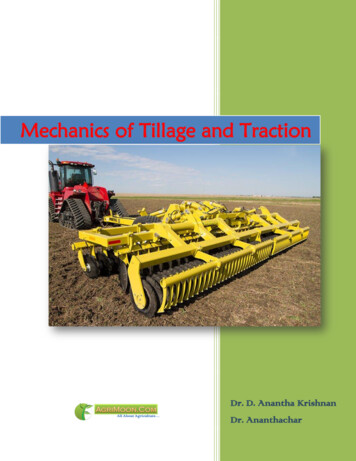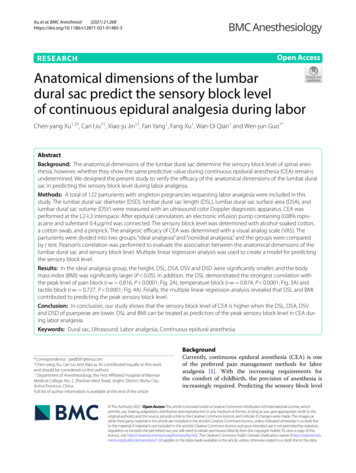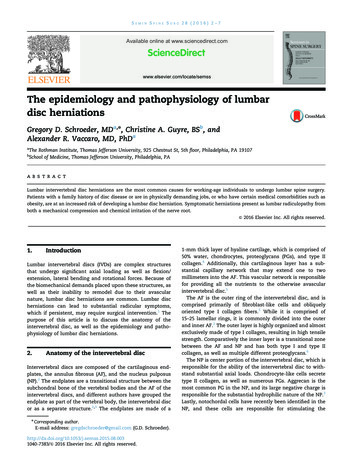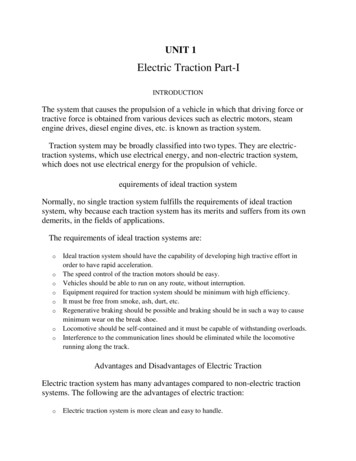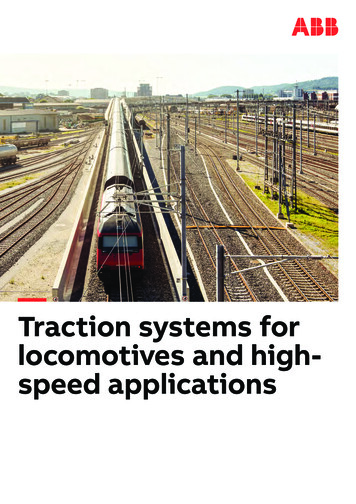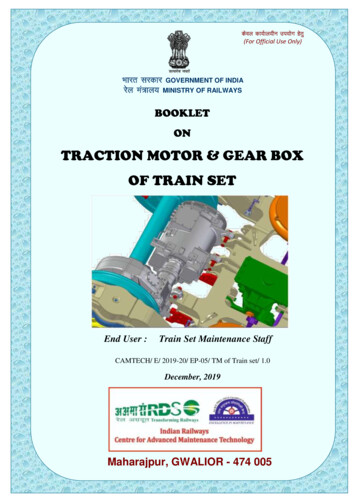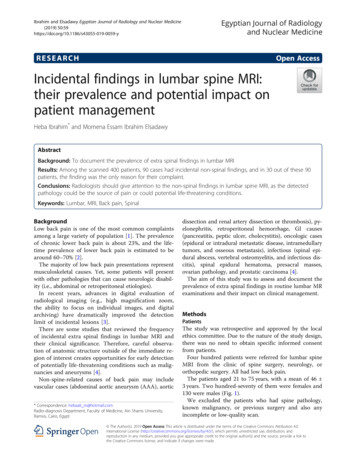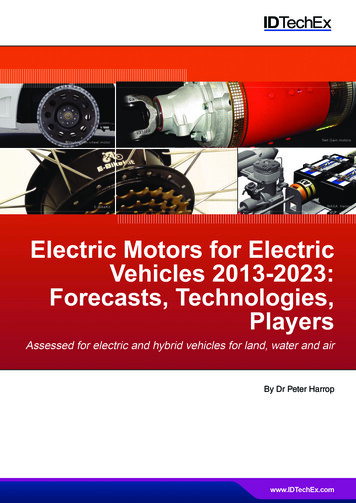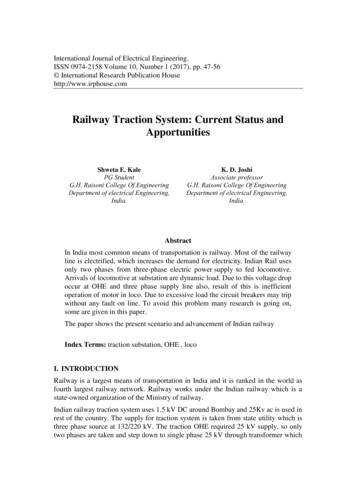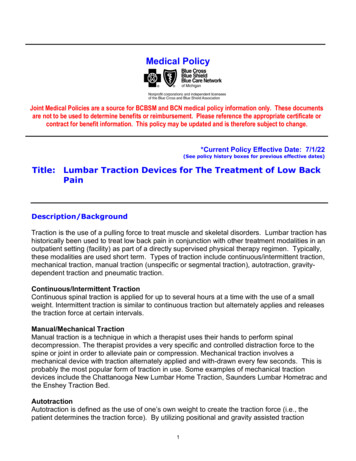
Transcription
Medical PolicyJoint Medical Policies are a source for BCBSM and BCN medical policy information only. These documentsare not to be used to determine benefits or reimbursement. Please reference the appropriate certificate orcontract for benefit information. This policy may be updated and is therefore subject to change.*Current Policy Effective Date: 7/1/22(See policy history boxes for previous effective dates)Title: Lumbar Traction Devices for The Treatment of Low BackPainDescription/BackgroundTraction is the use of a pulling force to treat muscle and skeletal disorders. Lumbar traction hashistorically been used to treat low back pain in conjunction with other treatment modalities in anoutpatient setting (facility) as part of a directly supervised physical therapy regimen. Typically,these modalities are used short term. Types of traction include continuous/intermittent traction,mechanical traction, manual traction (unspecific or segmental traction), autotraction, gravitydependent traction and pneumatic traction.Continuous/Intermittent TractionContinuous spinal traction is applied for up to several hours at a time with the use of a smallweight. Intermittent traction is similar to continuous traction but alternately applies and releasesthe traction force at certain intervals.Manual/Mechanical TractionManual traction is a technique in which a therapist uses their hands to perform spinaldecompression. The therapist provides a very specific and controlled distraction force to thespine or joint in order to alleviate pain or compression. Mechanical traction involves amechanical device with traction alternately applied and with-drawn every few seconds. This isprobably the most popular form of traction in use. Some examples of mechanical tractiondevices include the Chattanooga New Lumbar Home Traction, Saunders Lumbar Hometrac andthe Enshey Traction Bed.AutotractionAutotraction is defined as the use of one’s own weight to create the traction force (i.e., thepatient determines the traction force). By utilizing positional and gravity assisted traction1
principles, autotraction can provide multi-plane traction. Some of the brand names of thesedevices include the Spinalator Spinalign massage intersegmental traction table, the Arthrotonicstabilizer, the Quantum 400 intersegmental traction table and the Anatomotor.Gravity-dependent TractionAxial spinal unloading devices (gravity-dependent traction (i.e., axial spinal unloading devices)are designed to support the upper body's weight and transfer that weight to the hips via amechanical or pneumatic mechanism. Patient-operated spinal unloading has been suggestedas a conservative treatment for pain related to spinal disc disease or joint dysfunction. Severalpatient-operated spinal unloading devices are currently available on the market, including theOrthotrac Pneumatic Vest (manufactured by Kinesis Medical, Minneapolis, MN) and the LTX3000 (manufactured by Spinal Designs International, Minneapolis, MN).Pneumatic TractionPneumatic home lumbar traction devices have been developed which manufacturers claim canapply up to 200 pounds of traction force. Examples of these pneumatic devices includeautotraction devices include the Spinalator Spinalign massage intersegmental traction table, theArthrotonic stabilizer, the Quantum 400 intersegmental traction table and the Anatomotor.It is proposed that these devices mimic the traction offered in a clinical setting by providing afriction-free split surface that actively moves, enabling vertebral separation by inducing a pullingforce. It is suggested that when using these devices, the patient can be positioned so that thelumbar curve is in any degree of flexion, neutral or in extension. Each of these devices hasboth a patient-controlled pressure valve that limits the amount of force transmitted to the userand a hand-held pump for immediate release of pressure.Regulatory StatusTable 1. FDA Registered Devices for Lumbar TractionDeviceOrthotrac Pneumatic VestQuantum Intersegmental Roller TractionTableDRX5000SpineRx-LDMExtentrac EliteBass Antalgic-TrakTriton/Tru-Trac/TX/Triton DTS TractionCTBox Cervical/Lumbar TractionSystemGraviLax Traction SystemTM-400MTD 4000Lo-Bak TRAXEltrac 471Teeter Manual Inversion Table; TeeterCompanyClass TypeApproval DateOrthofix Inc.LSI International, Inc.Class IClass IIOctober 2000October 2000Axiom USA, Inc.Spine Rx TechnologyAdvanced Back Technologies,Inc.Traction Masters, Inc.Chattanooga GroupCircular Traction Supply, Inc.Class IIClass IIClass IISeptember 2002September 2003June 2004Class IIClass IIClass IISeptember 2004February 2006February 2007Therapeutic ClinicalTechnologiesITO Co., LtdMettler Electronics,CorporationBerthiaume ChiropracticMark Job Inc.STL International, Inc.Class IIMarch 2008Class IIClass IIJuly 2008August 2009Class IClass IIClass IJuly 2011September 2015December 20162
Forward Rotation DecompressionDevice; Teeter Portable DecompressionDeviceMedical Policy StatementThe use of mechanical, autotraction, gravity-dependent (axial spinal unloading) and pneumaticlumbar traction devices are experimental and investigational in any setting. These deviceshave not been scientifically demonstrated to be safe and effective for the treatment of low backpain, herniated disc or other indications and have not been shown to improve patientoutcomes.Inclusionary and Exclusionary Guidelines (Clinically based guidelines that maysupport individual consideration and pre-authorization decisions)Exclusions:Non-established lumbar traction devices include, but are not limited to Pneumatic lumbar traction devices (e.g., Saunders Lumbar HomeTrac, Saunders STx,Orthotrac Pneumatic Vest). Autotraction devices (e.g., the Spinalator Spinalign massage intersegmental traction table,the Arthrotonic stabilizer, the Quantum 400 intersegmental traction table and theAnatomotor) Axial spinal unloading (gravity-dependent traction) devices (e.g., LTX 3000, Triton DTS, ZGrav Spinal Decompression Table). Conventional lumbar traction using a pelvic harness attached to pulleys and weights, nowconsidered to be obsolete. Mechanical traction devices (e.g., Chattanooga New Lumbar Home Traction, SaundersLumbar Hometrac and the Enshey Traction Bed) Pettibon System (i.e., spine and posture correction and muscular development, therapeuticwobble chair, lumbar traction devices, weighting system). Lumbar lordotic curve-controlled traction devices (e.g., Kinetrac-9900)CPT/HCPCS Level II Codes (Note: The inclusion of a code in this list is not a guarantee ofcoverage. Please refer to the medical policy statement to determine the status of a given procedure.)Established codes:N/AOther codes (investigational, not medically necessary, etc.):E0830E0941E13993
RationaleTo date, no research has examined the reliability or predictive validity of manual unloadingtests of the lumbar spine to identify potential responders to lumbar mechanical traction.Swanson et al (2016) conducted a study to determine (1) the intra and inter-rater reliability of amanual unloading test of the lumbar spine and (2) the criterion referenced predictive validity forthe manual unloading test.1 Ten volunteers with low back pain (LBP) underwent a manualunloading test to establish reliability. In a separate procedure, 30 consecutive patients withLBP (age 50.86 11.51) were assessed for pain in their most provocative standing position(visual analog scale (VAS) 49.53 25.52 mm). Patients were assessed with a manualunloading test in their most provocative position followed by a single application of intermittentmechanical traction. Post traction, pain in the provocative position was reassessed and utilizedas the outcome criterion. The test of unloading demonstrated substantial intra and inter-raterreliability K 1.00, P 0.002, K 0.737, P 0.001, respectively. There were statisticallysignificant within group differences for pain response following traction for patients with apositive manual unloading test (P 0.001), while patients with a negative manual unloading testdid not demonstrate a statistically significant change (P 0.05). There were significant betweengroup differences for proportion of responders to traction based on manual unloading response(P 0·031), and manual unloading response demonstrated a moderate to strong relationshipwith traction response Phi 0.443, P 0.015. The authors concluded the manual unloadingtest appears to be a reliable test and has a moderate to strong correlation with pain relief thatexceeds minimal clinically important difference following traction supporting the validity of thistest.AutotractionThere are only two published randomized clinical studies comparing autotraction to other formsof traction; the results of these studies are conflicting. Telso and Merlo (1993) from Italyreported on a randomized clinical trial comparing conventional passive traction toautotraction.2 The investigators measured subjective response concerning overallimprovement, pain intensity using visual analog scale, qualitative pain severity using the McGillPain Questionnaire, and pain-related disability using the Oswestry Low Back Pain DisabilityScore. The favorable response to autotraction was 75 percent versus the 22 percent ofpatients to conventional passive traction.A study by Ljunggren et al (1984), however, found no differences in effectiveness betweenautotraction and manual traction.3 Forty-nine patients with lumbago-sciatica and prolapsedlumbar intervertebral discs, comparable concerning clinical data were randomized forautotraction and manual traction given by the same therapist for a period of one week whilestrict bed rest was prescribed. A blind overall assessment at specified intervals afterhospitalization showed that the two traction modalities are equally efficient. The authorconcluded that, as treatment for hospitalized patients with lumbar intervertebral disc prolapses,the relatively simple manual traction variety should be preferred, if any.Another 2 randomized clinical studies compared protocols that included autotraction withconservative management by a primary care physician; the results of these studies areconflicting. Moreover, since these latter 2 studies did not compare autotraction to other formsof manipulation, no conclusions about the comparative efficacy of autotraction can be drawnfrom them. Blomberg et al (1993, 1994) reported on the results of a controlled, multi-centerclinical trial comparing outpatients with acute or subacute LBP who were randomly allocated to4
either standardized but optimized conventional activating treatment by primary health careteams (n 53) or specific manual treatment such as manipulation, specific mobilization,muscle stretching, autotraction and cortisone injections (n 48).4 The treatment effect wasevaluated by standardized telephone interviews 3, 7, 14, 21 and 90 days after the start oftreatment. The authors reported that, in the early phase of treatment as well as at the 90 days'follow-up, the group receiving manual treatment had significantly less pain, less disability,faster rate of recovery and lower drug consumption than patients receiving conventionaltreatment, indicating that this type of treatment is superior to conventional treatment.Seferlis (1998) also compared a program that included autotraction to conventionalmanagement but found no differences in effectiveness.5 One hundred eighty patients, 95 menand 85 women aged 19-64 years, were randomized to three groups: an intensive trainingprogram, a manual therapy program that included autotraction or standard treatment by ageneral practitioner. No significant differences were found between the three groups in painintensity, functional status after one, three and 12 months.Gravity-dependent TractionJanke et al (1997) conducted a study evaluating the biomechanical responses evoked using agravity-dependent, self-operated traction device.6 These responses were determined byradiographs and were correlated with the body weight of the patient who was supported by aseat strap. The LTX 3000 Lumbar Rehabilitation System (Spinal Designs International,Minneapolis, MN) was used to administer the lumbar fraction. No previous study has beenconducted on this device. For each of the 14 healthy male patients (age range, 19-69 years),lumbar lengthening, alterations in spinal curvature, and thoracic spine movement wereassessed using radiographs taken: 1) before traction; 2) at 2, 10, and 15 minutes after theonset of traction; and 3) 2 minutes after traction was completed. Strain on the buttockssupporting seat strap was recorded continuously during study sessions. The entire patient pooldisplayed an average maximal lumbar lengthening of 6.39 /- 4.21 mm. The amount of lumbarlengthening was influenced by the degree of thoracic immobilization and by the amount of priorLTX 3000 (Spinal Designs International) use. Significant curvature reduction was observedduring and after traction for the entire patient pool. Strain measurements correlated well withthe measured response in the radiographs. The authors concluded that the proper use of theLTX 3000 (Spinal Designs International) appears to induce significant lumbar lengthening andcurvature reduction in health patients. Measurements of body weight supported by the seatstrap could help determine if thoracic immobilization has been achieved and if the patient isresponding to the lumbar unloading.Podein and Iaizzo (1998) measured forces applied to the body and associated changes inphysiologic responses during axial spinal unloading (gravity-dependent traction) using the LTX3000 Lumbar Rehabilitation System. Lumbar unloading was induced in 17 healthy subjects.7The following parameters were measured: (1) percent-age of total body weight unloaded; (2)forces applied onto and below the rib cage and local changes in cutaneous blood flow; (3)alteration of the applied forces to the seat strap associated with lumbar lengthening; and (4)changes in respiratory rates, respiratory minute volumes, heart rate, and blood pressure.The average pressure applied to the rib cage for thoracic immobilization without unloading was73 26 mm Hg. Lumbar unloading caused these pressures to increase by approximately 30%,causing complete but temporary occlusion of cutaneous blood flow in this region. Significant,but normal, reactive hyperemia occurred upon release of the rib support pads (p 0.05). Axial5
spinal unloading using an LTX 3000 induced changes in heart rate, blood pressure, andrespiratory rates of magnitudes similar to those reported with the use of other traction devices.The authors concluded that the forces applied to the rib cage by the LTX 3000 for properlumbar unloading appears to cause changes in physiologic responses, but these changeswere reversible and can be considered clinically unimportant and thus should not becontraindications to the use of this device by the general population.Pneumatic TractionDallolio (2005) presented a preliminary study on the conservative treatment of chronic LBPusing the Orthotrac device, a pneumatic custom made lumbar vest, which permits bothsupport-stabilization and decompression.8 The study included 41 patients (23 males and I8females, between the ages of 19 and 25 years) with radicular pain due to degenerativediscopathy including: dark disc, discal protrusion with neural foramina involvement, stenosis ofthe foramina, syndrome of the facets, Grade I listhesis. Patients had to wear the Orthotrac vestaccording to a precise protocol, 60 minutes 3 times a day for 5 weeks. Thirty-two patients(78%) showed a significant subjective and clinical improvement with subsequent better qualityof life and reported a decrease or disappearance of radicular pain. However, only short-termresults have been reported. The author concluded that further multicenter and interdisciplinarystudies on a greater number of patients in order to confirm the preliminary results.There are a lack of published peer-reviewed studies that have specifically evaluated the safetyand effectiveness of the Saunders Lumbar HomeTrac or Saunders STx home pneumatictraction devices for back pain. In addition, there is a lack of well-designed studies comparingthe safety and effectiveness of the Saunders Lumbar HomeTrac or Saunders STx with lumbartraction provided by a physical therapist. Well-designed controlled clinical studiesdemonstrating reductions in pain and disability and improvements in function are especiallyimportant in evaluating pain interventions because of the susceptibility of this symptom toplacebo effects. One is unable to determine from uncontrolled observations whether anynoted improvements are due to the application of home lumbar traction, the impact of anyother interventions that the patient was concurrently receiving, or the waxing and waningnatural history of chronic back pain.Published studies of traction as a treatment for low back pain lack methodological rigor andreach conflicting conclusions. A 2007 update of the Cochrane review of traction for low backpain, with or without sciatica, concluded from a review of 25 randomized controlled trials thatintermittent or continuous traction as a single treatment for low back pain cannot berecommended for mixed groups of patients with low back pain with or without sciatica.9Traction cannot be recommended for patients with sciatica because of inconsistent results andmethodological problems in most of the studies. A 2007 Agency for Healthcare Research andQuality (AHRQ) technology assessment concluded that currently available evidence is toolimited in quality and quantity to allow for formulation of evidence-based conclusions regardingthe efficacy of decompression therapy as a therapy for chronic back pain when compared withother nonsurgical treatment options.Home Tractionvan der Heijden and colleagues (1995) reviewed the literature on traction for back pain, andconcluded that "the available RCTs do not allow clear conclusions to be drawn about theeffectiveness of cervical or lumbar traction." A Prodigy Clinical Practice Recommendation6
states, based on the literature, that "traction does not appear to be effective for low back painor radiculopathy."13,14Several additional systematic evidence reviews have been published more recently that havereached these same conclusions about the lack of adequate evidence of lumbar traction forback pain.15,16 A Cochrane review on traction for LBP with or without sciatica (Clarke et al,2007) noted that various types of traction are used in the treatment of patients with LBP, oftenin conjunction with other treatments. These investigators concluded that that traction isprobably not effective. Neither continuous nor intermittent traction by itself was more effectivein improving pain, disability or work absence than placebo, sham, or other treatments forpatients with a mixed duration of LBP, with or without sciatica. They also noted that whilethere was moderate evidence that autotraction was more effective than mechanical traction forglobal improvement in patients with sciatica, these studies had methodological limitations andinconsistent results.Spinal Unloading DevicesThree studies examined the surface electromyographic (EMG) changes during axial spinalunloading using the LTX 3000 in normal subjects to determine the optimal time for effectivetraction.17-19 They reported on the short-term effect of LTX3000 on spinal curvature. Theyalso have reported on the biomechanical and physiologic changes during axial spinalunloading the LTX 3000. However, there is a lack of evidence regarding the clinical value ofLTX 3000 in improving clinical outcomes (reduction in pain and disability, improvements infunction) in patients with LBP.There are a lack of published peer-reviewed studies that have specifically evaluated the safetyand effectiveness of the Saunders Lumbar HomeTrac or Saunders STx (The Saunders Group,Chaska, MN) home pneumatic traction devices for back pain. In addition, there is a lack ofwell-designed studies comparing the safety and effectiveness of the Saunders LumbarHomeTrac or Saunders STx with lumbar traction provided by a physical therapist. Welldesigned controlled clinical studies demonstrating reductions in pain and disability andimprovements in function are especially important in evaluating pain interventions because ofthe susceptibility of this symptom to placebo effects. One is unable to determine fromuncontrolled observations whether any noted improvements are due to the application of homelumbar traction, the impact of any other interventions that the patient was concurrentlyreceiving, or the waxing and waning natural history of chronic back pain.The Orthotrac Pneumatic Vest (Orthofix, Inc., McKinney, TX) is an inflatable pneumatic vestthat has been promoted for use in relieving back pain from a variety of causes (e.g., herniateddisc, spinal stenosis, facet syndrome, spondylolysthesis, etc.). The Orthotrac was evaluated ina study of 41 patients with radicular pain due to degenerative discopathy.6,8 The investigatorreported that, after 5 weeks, 32 patients (78 %) have showed improvements on a SF-36inventory, and all patients referred a decrease or disappearance of radicular pain. Theinvestigator concluded, however, that “further multicenter and interdisciplinary studies on agreater number of patients are obviously needed to confirm these preliminary results.” Theprimary limitations of this study was the uncontrolled nature of this study, its short duration,and the subjective endpoints.Hahne et al (2010) determined the effectiveness and adverse effects of conservativetreatments for people who have lumbar disc herniation with associated radiculopathy7
(LDHR).20 These investigators searched 10 computer databases for trials published in Englishbetween 1971 and 2008. Trials focusing on people with referred leg symptoms andradiological confirmation of a lumbar disc herniation were included if at least 1 group receiveda conservative and non-injection treatment. A total of 18 trials involving 1,671 participantswere included. Seven (39 %) trials were considered of high quality. Meta-analysis on 2 highquality trials revealed that advice is less effective than microdiscectomy surgery at short-termfollow-up, but equally effective at long-term follow-up. Individual high-quality trials providedmoderate evidence that stabilization exercises are more effective than no treatment, thatmanipulation is more effective than sham manipulation for people with acute symptoms and anintact anulus, and that no difference exists among traction, laser, and ultrasound. One trialshowed some additional benefit from adding mechanical traction to medication andelectrotherapy methods. Adverse events were associated with traction (anxiety, fainting, lowerlimb weakness, and pain) and ibuprofen (gastrointestinal events). The authors concluded thatadvice is less effective than microdiscectomy in the short-term but equally effective in the longterm for individuals who have LDHR. Moderate evidence favors stabilization exercises over notreatment, manipulation over sham manipulation, and the addition of mechanical traction tomedication and electrotherapy. There was no difference among traction, laser, andultrasound. Adverse events were associated with traction and ibuprofen. They stated thatadditional high-quality trials would allow firmer conclusions regarding adverse effects andeffectiveness.Lordotic Curve-Controlled TractionLee and colleagues (2020) stated that lumbar traction is widely used as a non-operativetreatment for lumbar intervertebral disc disease.21 The effect of traditional traction (TT) usinglinear-type traction devices remains controversial for various reasons, including technicallimitations. These researchers compared the effects of a newly developed lumbar lordoticcurve-controlled traction (L-LCCT) device (the Kinetrac-9900) device and TT on functionalchanges in patients and morphological changes in the vertebral disc. A total of 40 patientswith lumbar intervertebral disc disease at the L4 to L5 or L5 to S1 level as confirmed bymagnetic resonance imaging (MRI) were recruited and divided into 2 groups (L-LCCT or TT).The comprehensive health status changes of the patients were recorded using pain andfunctional scores (the visual analog scale [VAS], the Oswestry Disability Index [ODI], and theRoland-Morris Disability Questionnaire [RMDQ]) and morphological changes (in the lumbarcentral canal area) before and after traction treatment. Pain scores were significantlydecreased after traction in both groups (p 0.05). However, functional scores andmorphological changes improved significantly after treatment in the L-LCCT group only (p 0.05). The authors suggested that L-LCCT is a viable option for resolving the technicallimitations of TT by maintaining the lumbar lordotic curve in patients with lumbar intervertebraldisc disease. These researchers stated that future studies should be carried out to reestablish traction guidelines such as intensity, interval, and treatment frequency, with the goalof obtaining the best results.The authors stated that this study had several drawbacks. First, although these investigatorsrecruited a sufficient sample size, more subjects of different ages are needed to generalizethese findings. As disease status could vary from individual to individual, these findings needto be carefully re-evaluated before they could be applied clinically. Age, sex, race, andindividual physical factors should also be considered in future studies. Second, vertebral discscould differ in several characteristics including resilience, softness, or severity. In this study,disc disease patients with relatively mild disabilities and low ODI scores were recruited.8
Regarding geometric status, pain threshold and functional outcome differences could also leadto different outcomes. Third, although this study recruited patients with more than 3 months ofunrelenting intervertebral disc disease, there was no control group without disc disease in thisstudy. As it is possible that disc disease could have resolved spontaneously, a control groupwith stricter requirements should be included in future studies. Finally, these researchersobtained immediate responses from patients following traction sessions, and the final outcomemeasurement was performed after completing 15 sessions of traction (approximately 1.5months). This did not reflect the long-term efficacy of traction treatment; thus, the long-lastingeffects of the treatment should be determined in future studies.Pettibon SystemThe Pettibon System is a comprehensive rehabilitation program for the spine’s hard and softtissues. The System’s use of specially developed weights, exercises, traction devices as wellas other products directly acknowledges that lasting spinal correction is related to thestrengthening of targeted muscles.In 2004, Morningstar et al investigated the possible benefits of using Pettibon correctiveprocedures to reduce the curvature associated with idiopathic scoliosis.22 A patient with a 35degrees left convex thoracolumbar scoliosis was treated using Pettibon corrective proceduresas well as devices. Initial and follow-up outcome measures included a Borg pain scale, aFunctional Rating Index, a balance test, and radiographic analysis. The patient was treatedusing a combination of manipulative and rehabilitative procedures designed to restore normalsagittal curves and reduce the severity of the coronal curvatures. After six weeks of treatment,the post treatment radiograph revealed a 20 degrees left convex thoracolumbar scoliosis, aswell as decreases in the Borg pain scale from six to two, and Functional Rating Index scorefrom 18/40 to 7/40 after the trial period. Her balance time increased from 18 seconds to 56seconds. The subjective and objective results of this case study require further investigations.In 2008, Schwab provided a case report describing the effect of exercise-based chiropractictreatment on chronic and intractable low back pain.23 The patient was treated with Pettibonmanipulative and rehabilitative techniques. At 4 weeks, spinal decompression therapy wasincorporated. After 12 weeks of treatment, the patient's self-reported numeric pain scale hadreduced from 6 to 1. There was also overall improvement in muscular strength, balance times,self-rated functional status, low back Oswestry scores, and lumbar lordosis using pre- andposttreatment radiographic information. This case suggests promising interventions withotherwise intractable low back pain using a multimodal chiropractic approach that includesisometric strengthening, neuromuscular reeducation, and lumbar spinal decompressiontherapy. However further controlled trials are needed to confirm results.The absence of controlled studies precludes any conclusions regarding effectiveness of theabove traction devices. These devices are considered experimental/investigational.9
SUPPLEMENTAL INFORMATIONPRACTICE GUIDELINES AND POSITION STATEMENTSNorth American Spine Society (NASS)10The NASS evidence-based clinical guideline for the diagnosis and treatment of cervicalradiculopathy from degenerative disorders notes that regarding the role of traction in thetreatment of cervical radiculopathy from degenerative disorders that cervical halter traction andcombinations of medications, physical therapy, injections and traction have been associatedwith improvements in patient reported pain in uncontrolled case series. They note that suchmodalities may be considered recognizing that no improvement relative to the natural history ofcervical radiculopathy has been demonstrated.The NASS evidence-based clinical guideline for diagnosis and treatment of lumbar discherniation with radiculopathy notes that there is insufficient evidence to make arecommendation for or against the use of traction in the treatment of lumbar disc herniationwith rad
Orthotrac Pneumatic Vest). Autotraction devices (e.g., the Spinalator Spinalign massage intersegmental traction table, the Arthrotonic stabilizer, the Quantum 400 intersegmental traction table and the Anatomotor) Axial spinal unloading (gravity -dependent traction) devices (e.g., LTX 3000, Triton DTS, Z-Grav Spinal Decompression Table).
